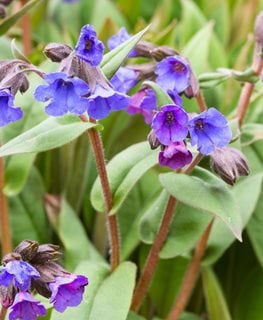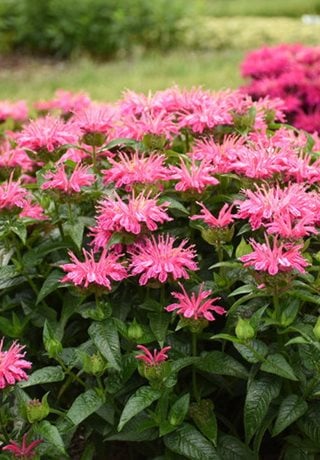Lungwort: A Guide to Growing Pulmonaria Plants
Prized for its attractive foliage and flowers, lungwort adds beauty to the shade garden from early spring into fall. Published 10/6/2022Lungwort (Pulmonaria) is one of the first perennials to bloom in spring, often sharing the spotlight with tulips and other spring-flowering bulbs. But the early display of pink and blue flowers is just the opening act for this showy shade lover. Once the blooms fade, lungwort’s striking dappled foliage takes center stage, growing fuller and even more attractive as the season progresses.
In fact, if you haven’t paid attention to lungwort for a while, it’s time to take a second look at this old-fashioned woodland favorite, says Larry Hodgson, author of Perennials for Every Purpose. “While most Pulmonaria used to have fairly ordinary rosettes of green leaves, now there’s a range of hybrids with leaves that are spotted or highly marbled with white or silver, giving the plants a much longer season of interest.”
In addition to offering a wide array of leaf patterns and variegations, many newer varieties of Pulmonaria also have greater disease resistance, improved longevity, and more vibrant flower colors, qualities that earn them a staring role in any shady garden.
On this page: Basics | Planting | Care | Varieties | Design Ideas
- BASICS
- HOW TO PLANT LUNGWORT
- LUNGWORT PLANT CARE
- LUNGWORT VARIETIES
- DESIGN IDEAS FOR USING LUNGWORT PLANTS
BASICS
Botanical name:
Pulmonaria spp. and hybrids. The genus name is derived from the Latin word plumo, meaning “lung,” since the spotted leaves were thought to resemble, and even cure, diseased lungs.
Common names:
Lungwort, Bethlehem sage, Jerusalem cowslip, spotted dog. (Not to be confused with Cerinthe species, also called lungwort.)
Plant type:
Perennial
Zones:
3-9
Exposure:
Partial to full shade
Size:
8 to 18 inches tall, 12 to 24 inches wide
Growth habit:
Forms a mounded clump that spreads slowly over time by underground rhizomes.
Bloom time:
Early to midspring, with the blooms lasting 3 to 4 weeks.
Foliage:
Usually ovate to elliptical in shape and slightly hairy. Color ranges from solid green, to green with silvery spots or blotches, to almost entirely silver, depending on the cultivar.
Flowers:
Small funnel-shaped flowers, borne in clusters, are usually pink when they emerge and change to bright blue or purple as they mature. Some varieties have pure white flowers.
Special attributes:
- Attracts bees and hummingbirds, providing a much-needed nectar source in early spring.
- Rabbit and deer resistant
- Few pest or disease problems
- Foliage remains evergreen in areas with mild winters, providing year-round interest.
GROWING LUNGWORT
When to plant:
In fall or in early spring after the threat of frost has passed.
Where to plant:
In light to medium shade, in moist, well-drained, humus-rich soil. A spot that receives morning sun and afternoon shade is ideal. Plants can be grown in full sun if enough moisture is provided, but dry, sunny conditions will often result in scorched and withered leaves. Lungworts also do not perform well in overly wet sites and can suffer from root rot in poorly drained, soggy soil.
How to plant:
Plant from nursery-grown transplants, digging a hole slightly wider and approximately the same depth of the container. Place the plant in the hole so the top of the rootball is about an inch below the level of the surrounding soil. Backfill, tamping the soil down gently, then water thoroughly.
Plant spacing:
Although lungwort has a moderate growth rate, its rhizomatous roots will cause it to spread and fill in an area over time. Space plants far enough apart (depending on their size at maturity) to allow some room for expansion. It’s also important to provide adequate air circulation between plants to prevent powdery mildew.
LUNGWORT CARE
Watering:
If you want lungwort to look its best all season, consistent watering is key. Plants can suffer during periods of drought and may even go dormant during prolonged dry spells. Give them a good soaking whenever the soil feels dry, providing enough water to keep the soil moist but not waterlogged. During periods of extremely hot weather, you may need to increase your watering frequency.
Amendments and fertilizer:
If your soil is low in organic matter, amend with compost or manure to improve moisture retention and fertility. When planted in nutrient-rich soil, lungwort rarely needs additional fertilization to thrive.
Pruning and deadheading:
Remove the entire flower stalk immediately after plants bloom to create a tidy appearance and stimulate healthy new leaf growth. If the foliage begins to deteriorate during the heat of midsummer, cut plants back to the ground and keep the soil moist. This will encourage fresh foliage to emerge for the cooler days of late summer and fall.
Propagation:
Division in the fall or right after flowering in the spring is the easiest way to multiply Pulmonaria plants. Dividing clumps every 3 to 5 years can also prolong plant life and boost bloom production. Although lungwort can also be propagated by seed (and may even reseed on its own), most varieties grown today are hybrids and won’t grow true to type.
Pests and diseases:
Lungworts have no serious pest or disease problems, but powdery mildew can develop on the foliage if plants are grown in wet, humid conditions. This can often be prevented by providing good air circulation between plants and avoiding overhead watering. You can also find cultivars that have been bred for improved mildew resistance.
PULMONARIA VARIETIES
DESIGN IDEAS FOR USING LUNGWORT PLANTS
- Use as a groundcover under trees and shrubs and in woodland gardens.
- Plant in the front of a shady perennial border, where the distinctive spotted leaves will be easily noticed.
- Use as a companion plant for spring-flowering bulbs and shade-loving perennials, such as hostas, bleeding hearts, and astilbes.
- Illuminate a shady corner by combining with other plants with silvery foliage, such as Japanese painted fern and ‘Jack Frost' heartleaf brunnera.














